
Tritik Software has introduced Moodal, a new plugin (VST/AU/AAX) for Mac and Windows that they say ‘modelizes objects and spaces to be excited by the sounds you will run through it’.
At the heart of Moodal is a resonance engine. Its underlying thousand resonant filters make Moodal capable of replicating realistic objects, such as strings or plates, but also to simulate reverberant spaces such as rooms and halls that require a high modal density.
Moodal’s controls have been designed to let you sculpt your sound deeply, yet easily.
The user interface, including 3 editable curves, allows you to quickly set up the resonators properties over the whole frequency range and to create unique timbres.
Features:
- Simulation of real and virtual objects and spaces
- Up to 1000 resonant filters
- Editable curves for frequency dependent amplitudes and decay-times
- Sensible parameters for modal density and spectral characteristics control
Audio demos:
Moodal is available for Mac OS X (AU/AU64/VST/VST64/AAX) and Windows (VST32/VST64/AAX) for €75, but is available for the introductory price of €35 until 15th November 2015.
Update: Audio demos added.

I guess we are left to our imaginations to hear what this is like. I’m sure many of us are reluctant to install a demo just to hear something for the first time. Hopefully some demo video will arrive soon!
I have just installed the demo SO YOU DON’T HAVE TO, it’s ok but i’m not going to buy it. some of the objects they model are ok, metal box, plastic bottle etc.. semi convincing textures. there’s a nice bell and something indian-ish that sounds good. the reverbs are not so great imo, would rather turn to valhalla for that.
Similar to the Spring Box effect I coded in Zed Synth. That can simulate sympathetic resonance on a piano, as well as creating metallic non-harmonic resonating reverbs. But it’s “only” got 88 resonators, whilst this has a 1000 – so not quite the same league
i hope it not a repeat item
or is it getting delayed
i cant help it
This comment does not resonate with me.
Thanks for the feedback
Is this really modeling spaces, or is it doing something more akin tomconvolving?
Judging from the UI, this sends the input signal into up to 1000 tuned delay lines (aka resonators). Each delay line has a pitch (they can be spread inharmonically) and a feedback gain (aka decay time) and probably a band-pass filter. So what this allows you to model is any sound composed of a series of exponentially decaying sinusoids. Inject a little bit of white noise into this, and you’ll get a nice metallic clang, or a dull tap on a wooden table top – it all depends how you set up the gains at each frequency and the decay time. In theory, these settings can be sampled from an existing sound to then resynthesize it though I don’t know whether this plug-in offers that option. Also I don’t think this is any form of modelling reverb for real acoustic spaces, it’s more like playing your music through a tin can or wooden block or … any other sort of resonating object, but it doesn’t include near or far or diffuse reflections, or pre-delay.
You can’t teach the pony many tricks, but it sounds good and unique. Definitely try the demo, very nice plugin I think. The price is good.
> Also I don’t think this is any form of modelling reverb for real acoustic spaces
well… did you check the demo ?
some demo sounds there also :
https://soundcloud.com/tritikaudio/electro-drumloop-cathedral?in=tritikaudio/sets/moodal-electro-drum-loop